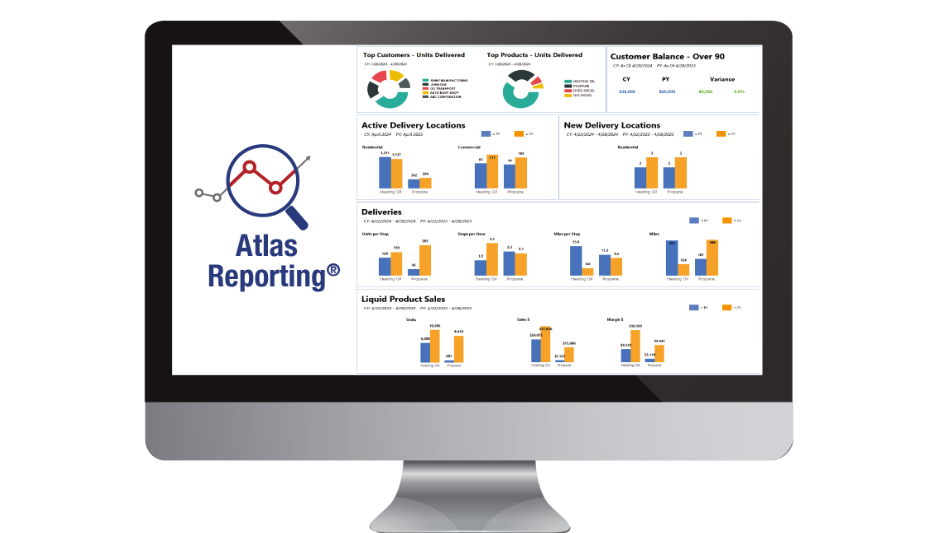All
Increase Fuel Delivery Efficiency with Business Intelligence Reporting
by Levi M. Jiorle, ADD Systems

Unlocking the fullest potential of your company data
In a fuel delivery business, profitability is heavily dependent on operational efficiency, and attaining the best possible efficiency means juggling many variables and making constant adjustments. You collect data with every delivery, but by using that data to its fullest potential, you can find huge opportunities. Manual analysis of data can seem overwhelming, but this is the perfect task for business intelligence (BI) reporting.
Bring the Delivery Exceptions to Your Attention
BI reporting can help direct your attention to the right places so that you don’t waste time. Rather than looking at every delivery, you can investigate only deliveries that fall outside your acceptable range. Reporting on suboptimal deliveries is common, helping to identify which tanks need to be reviewed and adjusted. Deliveries that are too small or too large, made too many days before they were scheduled or too many days after, are just some examples of important exceptions that deserve investigation.
“One example of a delivery notification that has been helpful is pricing alerts,” Bryan Walline, Lead Developer of Business Intelligence at ADD Systems said. “Receiving a notification any time that deliveries are being made while operating off of potentially outdated pricing data allows users to step in and make corrections as soon as possible, thus helping the business avoid a loss in their deliveries’ profitability.”
Notifications and reports like these help streamline activity, bringing focus to only those things that need attention. It’s management by exception and it is efficient.
Watch Your Driver Productivity
Individual delivery transactions are important, but so is the productivity of your drivers. BI reporting lets you see an up-to-date analysis of all your drivers’ activities.
“Metrics like Stops per Hour, Volume per Hour, and Distance per Stop help determine how efficient a driver’s routes are and how effective the driver is at making it through their route,” Walline said. “Low Stops per Hour could indicate that the driver is less productive with their time, while a high Distance per Stop value can be a sign that the driver’s route covers too much area and can be further optimized.”
Keep a Close Eye on Your KPIs with Dashboards
Driver productivity is just one of the measurements needed to effectively manage a delivery operation, but there are also several other key performance indicators (KPIs) to watch. Having all of them always available on a dashboard gives true visibility and a quick picture of the entire operation.
“Dashboards are a great way for upper management to quickly check the pulse on different areas of their company’s business, such as Sales and Profitability, Accounts Receivable, Delivery Efficiency, Customer Gain/Loss, and Inventory,” Walline said. “Each customer has their unique preferences on how this information is presented to them, whether they use different metrics to determine success, choose to see highly-summarized KPIs over a more detailed scorecard-like approach, or whether they compare the current measurements to last year’s performance rather than a pre-established goal.”
No More Manual Spreadsheets
Some organizations pull out KPIs through manually crafted spreadsheets with data pulled from multiple sources. This not only is extremely time-consuming, but it also poses a risk to the data integrity.
“Having an employee spend hours of their week just running reports is an unnecessary use of company time. Automating that process will save the business money and free up employees to focus on areas where it is better spent,” Walline shared. “Manual processes will always be subject to human error, such as mistyping a value into a spreadsheet or accidentally running a report with the wrong criteria.”
All manual processes introduce the possibility of errors and ultimately trust in the reports. BI reporting bypasses this risk by pulling the data right from the source. It’s all automatic.
Quick Drilldown to the Details
KPIs help with a high-level picture, but dashboards and reports can also offer drill-down capability, so you can get right to the root of a problem. For example, a dashboard that shows three zero-gallon stops on a particular day can give you the ability to click on those stops and review the account details for each. You can investigate immediately and reach out to the customers to make any scheduling adjustments necessary to help ensure it doesn’t happen again.
“High-level, summarized data can be beneficial for quick analysis, but the ability to drill through to detailed data is essential when further investigation is required,” Walline said. “For example, a KPI displaying the business’s Average Margin per Gallon offers a great overview of profitability. But, if end users want to find ways to improve in that area, having the ability to drill down to the details of the transactions that contribute to the KPI makes that task much quicker and easier.”
You Already Collect the Data. Use It!
Business intelligence reporting is an essential tool, enabling you to take full advantage of all the data you already collect to help you become the most efficient company you can be. “When managing your business, having access to correct information in a timely manner empowers you to make good, informed business decisions,” shared Walline. From dashboards that keep a close eye on your operation, to exception reporting with easy drill-down capabilities, to automatic notifications to be informed of issues immediately, BI reporting helps you stay informed and manage your business better than ever.
Levi Jiorle is a Content Writer for energy software company ADD Systems. He can be reached at (973) 584-4026 x 1347 or jiorlel@addsys.com.
Related Posts
 Reflecting on an Incredibly Successful 2025
Reflecting on an Incredibly Successful 2025
Posted on December 31, 2025
 Thinking about Onsite Storage? Start Here.
Thinking about Onsite Storage? Start Here.
Posted on December 23, 2025
 Jim Collura’s First Year as NEFI President and CEO
Jim Collura’s First Year as NEFI President and CEO
Posted on December 22, 2025
 NEFI-Backed National Energy Choice Legislation Advances
NEFI-Backed National Energy Choice Legislation Advances
Posted on December 22, 2025
Enter your email to receive important news and article updates.
